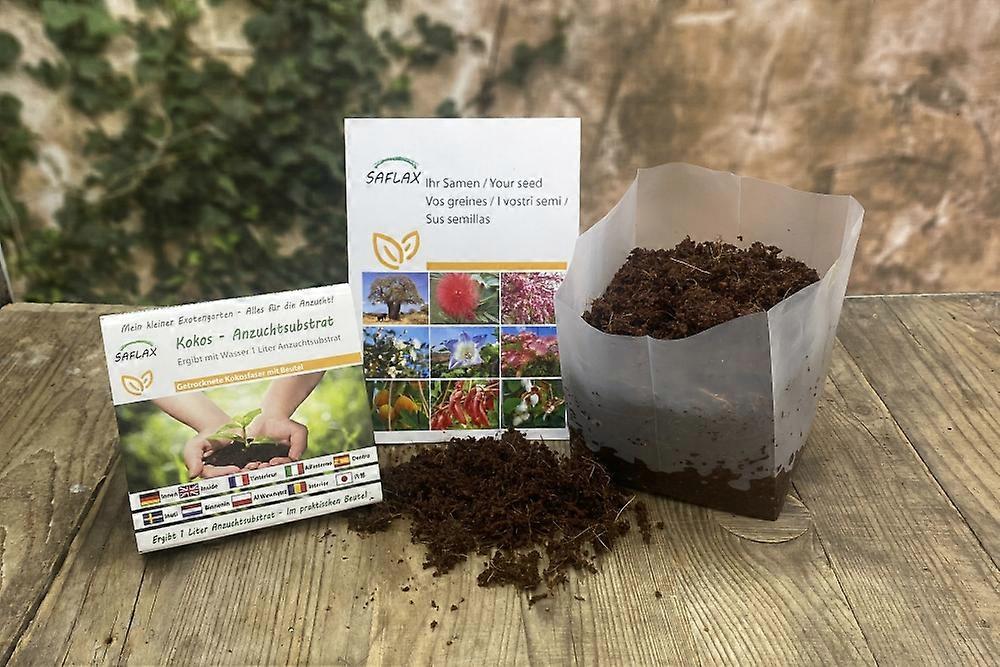Tanım
Saflax - Luffa sponge cucumber - Luffa aegyptica - 10 seeds - Delicious in salads and also practical as a care sponge. Create the optimal environment for successful cultivation straight away. Garden in the Bag supplies the growing substrate in a practical, self-erecting bag. Simply add water and watch as the dried, lightweight block creates plenty of growing substrate for your seeds in just a few minutes. Worth knowing: The loofah is mainly cultivated for its fibrous tissue skeleton. However, the still young vegetable can also be used in the kitchen for dishes.. Natural Place: The plant is mainly found in the tropical regions of Asia and Africa. Cultivation: The preculture should take place in March / April at room temperature. First, slightly roughen the seed coat with a file and then soak the seeds in water for 24 hours to stimulate the germination process. Then place the seeds one to two centimeters deep in the growing medium. Keep the substrate moist but not wet, preferably by dampening it with a spray bottle every day. Cover the culture vessel with cling film, which you provide with holes. This protects the soil from drying out. Every two days you should remove the foil for 2 hours. This prevents mold from forming on the growing soil. Place the culture vessel in a light and warm place with a temperature between 20° and 25° Celsius. The first seeds germinate after two to three weeks. Now remove the cover and keep the plants in as much light as possible (but not in the blazing midday sun) and a little cooler so that the young plants do not wither. They should only be planted out in the garden after the ice saints, when no more night frosts are to be expected. Place: Due to its origin, the luffa needs a warm location with as much sun and protection as possible. A small greenhouse is ideal in our latitudes. However, it can also be kept in a sufficiently large planter on a sheltered terrace or a balcony that is not drafty. Care: As a lush climbing plant with long tendrils, you should support the luffa with an appropriate climbing frame and ensure a planting distance of at least 50 centimeters so that the sponge cucumber can develop without restrictions. The luffa needs a loose, humus-rich soil and constant soil moisture. Water extra during prolonged dry spells. You should provide the plant with a liquid vegetable fertilizer every four to six weeks. When the long cucumbers turn yellow in early autumn and the skin breaks even with the slightest pressure, the fruits are ready to be harvested. Fruits that are harvested early and are still unripe and tender can be used raw like conventional cucumbers and have a taste similar to zucchini. If you want to process the young cucumbers into sponges, peel the fruit and cut off the ends generously. Then the loofah should be soaked in a water bath for several days. After that, the pulp and seeds are carefully removed under running water. The remaining framework is dried in an airy and warm place for a few days. The white mesh of the loofah is hard and rough when dry, but softens in water and can be used for gentle skin care, as a sustainable and compostable household sponge or cut into strips as a soap base. During Winter: The luffa cucumber is an annual and is sown again the following year. Bonsai: No Picture credits: Because of technical limitations links are shown as text. 63504-luffa-aegyptica-seed-package-front-german.jpg - About © : Contact SAFLAX - - saflax.de/copyright 13504-luffa-aegyptica-cultivation-instruction-german.jpg - Frank Laue - © Saflax - saflax.de/copyright - - - - - - - - - - - - - - - - - - - - -
-
Fruugo Kimliği:
374194760-810677551
-
EAN:
4055473635040

